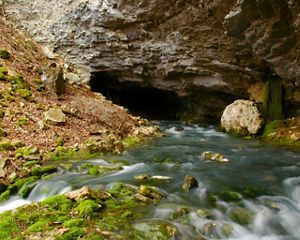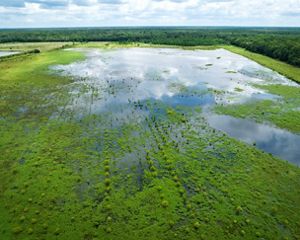Protecting Freshwater in Arkansas
From rivers to underground caves, The Nature Conservancy is protecting the waters that shape Arkansas and sustain its future.

Across the Ozarks and Ouachitas, water connects everything. Rivers and streams wind through forested hillsides. Springs bubble up from the ground, feeding creeks and nourishing wildlife. Deep underground, caves and karst systems hold rare species found nowhere else in the world. These freshwater systems are part of Arkansas’ identity and they’re essential to our future.
The Nature Conservancy is working to protect these waters through a strategy that’s focused, flexible and built for impact. With your support, we’re teaming up with landowners, communities and local governments to take on the most urgent and complex challenges to meet our ambitious goals.


Our work includes restoring and protecting streamside forests, improving unpaved roads to reduce runoff and reimagining old and failing stream crossings that block natural flow.
Underground, our karst program is expanding to explore and protect some of the most biologically rich cave systems in the country. A recent assessment identified 45 high-priority sites across northern Arkansas that support rare and sensitive species, including cavefish, crayfish, bats and other species found only in this region. We are working with landowners to assess these habitats, offer conservation support and improve conditions for the unique life that depends on them.
Your support helps us move quickly, respond to new opportunities and protect the waters that keep Arkansas strong. Together, we’re making sure these rivers, springs and caves remain clean, healthy and full of life for today and for generations to come.
Arkansas’ Hidden Biodiversity
More than 13,000 caves and numerous springs have been documented across the Ozarks. These habitats are rich in biodiversity, and more than 100 cave-dwelling species call them home. While much of TNC’s Interior Highlands Karst Initiative focuses on ensuring healthy underground habitats and clean groundwater for these species, staff occasionally discover something new while crawling around underground.
Quote: Mike Slay

Though caves are underground, protecting them often begins with conservation practices on the land above. In this way, our freshwater and land goals are deeply intertwined.
Hotspots such as the Ozarks are a prime region for discovering new species, and TNC works closely with scientists to name these species and understand how to conserve them. Recently, Mike Slay, TNC’s Ozark Karst Program manager, helped discover a new spring isopod. This new Arkansas species was named Lirceus slayorum, or Slay’s spring isopod, to honor his conservation efforts.
Community-driven Conservation
In 2024, TNC partnered with Madison County to design a bridge over War Eagle Creek, near Aurora, that would replace an aging slab crossing to enhance stream health and resilience. But record-breaking rainfall in 2025 overwhelmed local infrastructure, prompting the county to shift priorities.
TNC responded quickly to Madison County’s request, pivoting to a new priority: two failing culvert crossings on Fritts Creek, a tributary of the White River. These crossings had blown out multiple times in the past year, as seen in the photo to the right, sending sediment downstream, threatening water quality in Beaver Lake—a vital drinking water source for northwest Arkansas—and requiring constant, costly county maintenance. TNC worked with the county to design flood-resilient, wildlife-friendly crossings to reduce erosion and protect clean water.
Your support enables TNC to be nimble in our approach to conservation, meeting communities’ most pressing needs and delivering lasting environmental impact.
Sign up for Nature News.
Sign up to receive monthly conservation news and updates from Arkansas.


